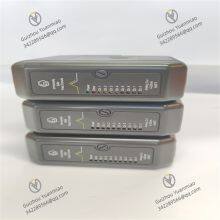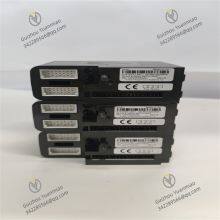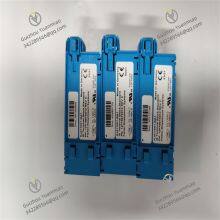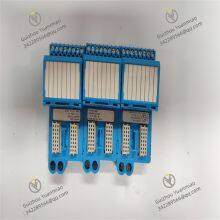Material
Other, Global universal model
Condition
Other, Global universal model
Task
Other, Global universal model
Mathematical Model
Other, Global universal model
Signal
Other, Global universal model
Customized
Non-Customized
Structure
Other, Global universal model
Operating temperature
-40°C to 70°C
Output voltage
24V DC
Dimensions
160mm×100mm×30mm
I. Overview
VE4013S2B1 is a high-performance M-series redundant serial interface card in Emerson's DeltaV™ system. It is mainly used to realize high-speed and stable data interaction between the DeltaV™ control system and various field devices that support serial communication protocols (such as Modbus RTU/ASCII, Allen-Bradley Data Highway Plus, etc.).
As a redundantly designed interface card, it can provide uninterrupted communication guarantee in key industrial automation scenarios (such as chemical production, petroleum refining, power dispatching, etc.). Through the dual-port redundancy and automatic fault switching mechanism, it effectively reduces the risk of system communication interruption caused by single-point faults, and is one of the core components for building a highly reliable industrial control network.

II. Technical Parameters
Port configuration: Equipped with 2 independent serial communication ports, supporting multiple interface types including RS-232, RS-422, RS-485 (half-duplex/full-duplex), which can be switched through software configuration; a single port can connect up to 32 slave devices, and the total data set processing capacity reaches 64 (32 per port).
Communication parameters: The baud rate is adjustable from 300bps to 115200bps; the parity modes include no parity, odd parity, and even parity; the data bits can be set to 7 or 8 bits; the stop bits support 1 or 2 bits, which is compatible with the communication configuration requirements of mainstream serial devices.
Redundancy capability: Supports 1:1 redundancy architecture. The active and standby cards synchronize the communication status in real-time. The fault switching time is ≤100ms, and there is no data loss during the switching process, ensuring the continuity of the communication link.

Electrical isolation: Both the port and the system, and between ports adopt photoelectric isolation design. The isolation voltage is ≥2500V AC (for 1 minute), and it has ±2kV electrostatic discharge (ESD) protection capability, effectively resisting electromagnetic interference and surge impact in industrial fields.
Power parameters: The working voltage is 24V DC (±10%). The typical power consumption of a single card is ≤5W, and the total power consumption in the redundant state is ≤10W, which is compatible with the standard power module of the DeltaV™ system.
Environmental adaptability: The operating temperature is -40°C to 70°C, the storage temperature is -40°C to 85°C, the relative humidity is 5%-95% (no condensation), and the protection level is IP20, which can operate stably in high-temperature, humid, and dusty industrial environments.
Physical specifications: Adopts a DIN rail-compatible card design, with dimensions of 160mm×100mm×30mm (length × width × height) and a weight of about 200g. It supports hot-swapping for convenient online system maintenance.

III. Functional Features
Redundant communication guarantee: Through the parallel operation and real-time status monitoring of the active and standby cards, when the active card has abnormalities such as communication interruption and port failure, it will automatically switch to the standby card. The switching process does not affect the system data transmission, meeting the strict requirement of "zero interruption" in industrial control.
Flexible adaptation to multiple protocols: Built-in protocol parsing engine, natively supporting mainstream serial protocols such as Modbus RTU/ASCII, DF1, Data Highway Plus, etc. The protocol parameters can be quickly configured through DeltaV™ configuration software without additional driver programming, simplifying the integration process of heterogeneous devices.
Enhanced anti-interference design: In addition to high-voltage isolation, the port is also integrated with hardware filter circuits and surge suppression components, which can maintain communication stability near strong interference sources such as motors and frequency converters, reducing the data transmission error rate (bit error rate ≤1×10⁻⁹).
Hot-swapping and plug-and-play: Supports online plugging and unplugging operations. There is no need to shut down the control system when replacing the card, reducing maintenance downtime; after being connected to the DeltaV™ system, it is automatically identified and the driver is loaded. Parameter configuration can be completed through a graphical interface, shortening the debugging cycle.
Comprehensive status diagnosis: The card has a built-in temperature sensor and communication status monitoring module, which uploads information such as power status, port connection, data transmission rate, and the number of redundancy switches to the DeltaV™ workstation in real-time. The operating status is intuitively displayed through LED indicators (power, communication, redundancy status), facilitating quick fault location.

IV. Common Faults and Solutions
Frequent redundancy switching
Possible causes: Excessive synchronization clock deviation between the active and standby cards; poor contact of communication cables leading to false fault judgment by the active card; power supply voltage fluctuation exceeding the ±10% range; poor heat dissipation of the card leading to overheating and triggering protection.
Solutions: Calibrate the synchronization clock of the active and standby cards through the DeltaV™ engineer station; check the communication cable connectors, replace aging or poorly connected connectors, and ensure the shield is grounded at one end; use a multimeter to detect the power supply voltage, and replace the regulated power supply module if necessary; clean the dust in the card's heat dissipation holes, improve the ventilation conditions of the control cabinet, and ensure the working temperature is ≤70°C.
Port communication interruption
Possible causes: The port settings do not match the slave device (such as incorrect baud rate or parity); the RS-485 bus terminal resistor is not connected (120Ω is recommended) leading to signal reflection; the port is damaged by electrostatic breakdown; address conflict or failure of the slave device causes bus blockage.
Solutions: Check and unify the communication parameters between the port and the slave device; connect terminal resistors at both ends of the bus; use an oscilloscope to detect the port signal, and replace the card if hardware damage is confirmed; disconnect the slave devices one by one to check for address conflicts or faulty devices, and reconnect them to the bus after recovery.

High data transmission error rate
Possible causes: The communication cable does not use twisted-pair shielded wire, resulting in electromagnetic interference; the bus length exceeds the maximum transmission distance (RS-485 maximum 1200 meters); the slave device response timeout is set too short; the card's filter parameters are set improperly.
Solutions: Replace with twisted-pair cables with a shield, and keep them away from high-voltage cables (distance ≥30cm); add RS-485 repeaters to extend the transmission distance; extend the slave device response timeout in the configuration software (it is recommended to be 500ms-1000ms); adjust the port hardware filtering level through the engineer station (medium by default, can be set to high in strong interference environments).
The card cannot be recognized by the system
Possible causes: The card is not correctly inserted into the slot, resulting in poor contact of the golden fingers; the firmware version is incompatible with the DeltaV™ system version; the power module fails, causing power supply interruption; the internal program of the card runs away.
Solutions: Re-plug the card to ensure it is fully tightened; upgrade the card's firmware to a version compatible with the system (through Emerson's official tools); replace the backup power module for testing; perform a cold reset on the card (power off for 10 seconds and then restart). If it still cannot be recognized, it is judged as a hardware fault, and the card needs to be replaced.


















































